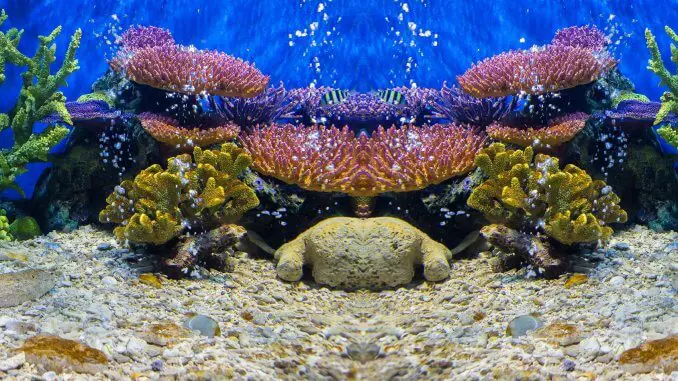
If you are new to the aquarium hobby, you are probably overwhelmed by what exactly you need to buy for your fish tank.
Air pumps are one of those items that don’t quite make it onto the essentials list, but nevertheless they are extremely popular and a lot of people choose to include them in their tanks.
It provides a number of useful services – this piece of equipment is usually quite a basic yet effective addition to the tank.
But what exactly is an air pump, how do they work and do you need one?
In our guide below we will answer all these questions, along with reviewing five of the most popular aquarium air pump available.
What is an Aquarium Air Pump?
| PRODUCT | FEATURES | LATEST PRICE |
|---|---|---|
 1. Tetra Whisper Easy to Use Air Pump for Aquariums |
| Check Price |
 2. EcoPlus HGC728459 Eco Air7 Air Pump |
| Check Price |
 3. Mylivell Quietest Aquarium Air Pump Ultra Silent |
| Check Price |
 4. Pawfly MA-60 Quiet Aquarium Air Pump |
| Check Price |
 5. Hygger Quiet High Output 10W Aquarium Air Pump |
| Check Price |
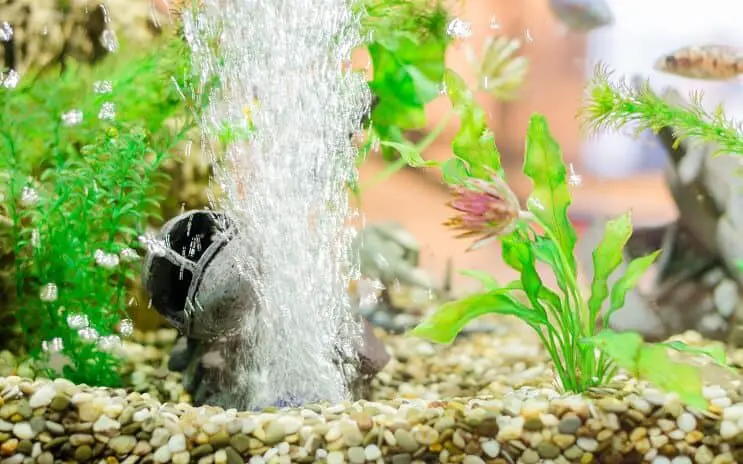
An aquarium air pump forces air into the water in your tank.
This process displaces the water, and the air which is pulled through the pump, creates bubbles which are released into the water.
The bubbles create a current in the water, and send carbon dioxide to the surface of the water. Carbon dioxide and other excess gases leave the water, and oxygen is taken in by the water.
This provides fish with more oxygenated water.
Some aerators use portable power, so we suggest using a d cell battery for the Fish Tank Aerator.
How Does An Air Pump Work?
An air pump works in two main ways:
1. By increasing the surface area
When air is pumped into the water, it moves the surface which increase the surface area of the water. By increasing the surface area, there are more opportunities for oxygen to enter the water through gas exchange.
At the surface of the water, carbon dioxide and other excess gasses are released into the air, and oxygen is taken in.
Therefore the more bubbles the pump makes, the more oxygen the water is able to take in.
2. By improving circulation
Air pumps also improve the circulation in fish tanks by moving the water around. It encourages the water from the bottom of the tank to move up to the surface where it can release carbon dioxide and take in oxygen.
The Best Aquarium Air Pumps Reviewed
Best Value: Tetra Whisper
Best Value Aquarium Air Pump
This efficient and easy to install air pump is perfect for a 10 gallon aquarium. It is both reliable and affordable.
This air pump has a unique dome shape which makes it look better than other pumps.
It has a sound dampening chamber which produces a quiet stream of air, minimizing the amount of turbulence in the water.
This is a powerful and reliable pump which provides all the aeration needs for a 10 gallon tank.
It also comes in a number of different sizes to suit aquariums up to 300 gallons.
Pros:
- Very reasonably priced.
- It is quiet when placed on a solid, dense surface.
- This pump is great for small aquariums.
- Rubber feet on each leg reduce vibrations.
Cons:
- Does not come with any tubing.
- Pump needs replacing every two years.
- You can’t adjust the flow of the air.
Large Pump: Commercial EcoPlus Pump
Best Large Aquarium Pump
If you are looking for a pump which is large enough to provide oxygen over multiple systems, hydroponic setups or fish farms, this is the one for you.
This air pump is ideal for any large or commercial set up.
It is also an ideal pump for outdoor ponds. This pump comes in various sizes, providing you with four to sixteen outlets.
The pump is extremely strong and durable, and comes with all the fittings you need to set it up.
Pros:
- Valves are extremely accurate and fit perfectly.
- It moves a huge amount of air in comparison to other pumps.
- Well-made and heavy duty unit.
- Comes with 12 months warranty.
Cons:
- Pump produces quite a lot of noise.
- Only 6 inches of tubing provided – so you might need to buy more.
- Have to remove plastic cover to clean the foam filter.
Quietest: Mylivell Ultra Silent
The Quietest Air Pump
This quiet pump is perfect for tanks in your bedroom, or rooms which you don’t want to be able to hear a loud noise.
This pump is unlike any others on the market. It does not have a motor, shaft or electromagnetic system like the majority of other pumps available.
Instead it is driven by a thin ceramic plate which makes it very small, very quiet and very lightweight.
It is so quiet than you have to hold it up to your ear to hear any noise at all.
This pump comes in two sizes. One is suitable for up to 13 gallon, the other one is ideal for tanks which are up to 40 gallons.
Pros:
- Very easy to set up.
- Comes with an air tube and an air stone.
- Can be fitted outside the tank to save space.
- Available in two colors – black and white.
Cons:
- Can only connect to one device.
- It is expensive in comparison to other pumps.
- Power cord is quite short (only 3 feet long).
Adjustable: Uniclife Pump
The Adjustable Air Pump
This pump comes with everything you need to provide air quietly, maintaining the oxygen levels in your water.
The Uniclife Adjustable air pump is a small unit which has low power consumption.
Being adjustable, it means you can decrease or increase the flow rate which makes it perfect for any tank between 20 and 100 gallons.
With a rotating dial to control the dual port outlets, you can either put it on a higher setting to create more air and bubbles, or a low setting to create less.
It has two outlets so can be connected to two different pieces of equipment.
This pump is really easy to set up and the instructions are simple to follow.
Pros:
- Complete set comes with everything you need to aerate your aquarium.
- Has an adjustable air flow.
- Powerful pump, great for providing aeration for two air stones.
- It has a sturdy feel and is a quality well-made pump.
Cons:
- Reasonably quiet but not entirely silent.
- Hose is quite bulky.
- The higher the flow rate, the nosier the pump is.
Best: Hygger 30-600 Gallon Pump
The Best Aquarium Pump
This 10W powerful pump can aerate tanks from 30 gallons, all the way up to huge 600 gallon setups.
This is the most powerful aquarium pump which we are featuring.
The pump was manufactured using a bearingless motor so it does not create much vibration or noise.
This pump is too powerful for tanks which are smaller than 30 gallons, but it can be used for tanks which are anywhere from 30-600 gallons.
It comes with two air outlets, but you will need to buy some 4mm air tube to connect the pump to the air stones or bubbler.
Pros:
- Very quiet because of the magnetic bearings design.
- It can aerate multiple tanks at a time.
- Insulated stainless steel case reduce the noise even more.
Cons:
- The air flow is not adjustable.
- Still louder than other smaller pumps.
- Expensive in comparison to other pumps.
Does Your Fish Tank Need An Air Pump?
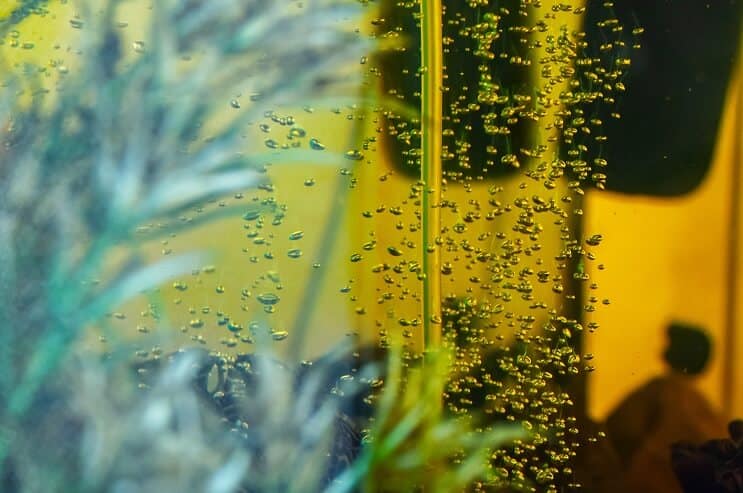
There are lots of reasons why you might want to use an air pump in your tank. The first and most common reason is to provide your fish with more oxygen.
All fish need oxygen to breathe, and most use their gills to absorb dissolved oxygen from the water. All aquariums absorb oxygen into the water at the surface, but by using a pump, you will increase the amounts of oxygen in the water.
However if you have a HOB filter or a canister filter, the chances are you probably won’t need an air pump, because the filter will already be agitating the surface of the water enough to oxygenate it.
Here are a few instances where you might either need an air pump, or where you might like to include one in your setup:
- Air pumps can be used to help circulate areas of water to stop them becoming stagnant. For example if you have an area which is closed in by ornaments or plants, you might want to place a pump and stone there.
- If you are trying to replicate the natural conditions of a medium to fast flowing body of water, such as a river, you can use an air pump to create more movement in the water. You will probably also want to use a powerhead as well as a filter and pump to create a nice water flow.
- Air pumps are also necessary for some equipment such as filters and protein skimmers. For example, if you have an undergravel filter, you will most likely need to by an air pump to allow the filter to function.
- Some ornaments and decorations only function with the use of an air pump, for example spinning wheels or erupting volcanoes.
- Air pumps can be connected to air stones to create bubbles in the tank. For some people, this is the reason to include a pump – simply for the look of the bubbles. So as well as watching the fish gracefully swimming around, watching the bubbles rise up to the top of the tank can also be very relaxing.
- Air pumps are commonly needed for semi-aquatic animals such as Frogs, Newts, Salamanders, and Crabs.
How To Choose The Right Air Pump?
Most pumps come with the recommended aquarium size on them.
Always try to choose a slightly larger pump than you think you will need, especially if you have a deep tank.
The main factors which will affect your choice will be:
- Price
- Size
- Equipment
- Noise
Price
Pumps vary hugely in price – they range anywhere from $6 to a few hundred dollars.
If you are on a budget you will want to find a good value for money pump. Whereas if you have a long-term more professional set up, you will likely choose a more expensive unit which will last a long time.
Size
The size is an important factor when it comes to choosing which pump you want to buy.
Some units are very small and can be hidden away, whereas others are larger and require much more space.
Consider where your pump will go, and how much space you have before buying one.
Equipment
How many pieces of equipment do you want to connect it to?
Some air pumps only have one connection point, which is perfect if you only have one piece of equipment to power.
However what happens if you want to power a couple of ornaments, an air stone and an undergravel filter? You will need a pump with multiple connection points.
Noise
How quiet it is?
One of the main factors people look at when they research a product is how quiet the pump is.
If your fish tank is in a main living area within your home, the chances are you will need a quiet unit which does not produce lots of noise.
How To Set Up Your Aquarium Air Pump
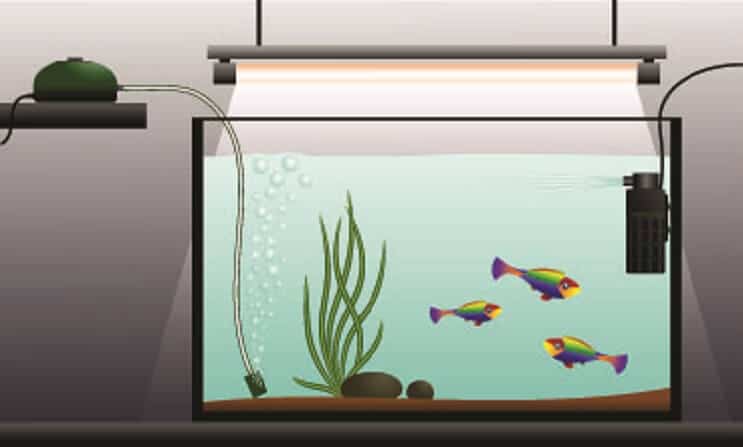
Most pumps are not waterproof and will need to be set up outside the tank – they also usually need to sit above the water level.
By placing it above the water level, it will stop water from flowing back into the pump (this will break your pump). If you need to place your air pump lower than water level, make sure to use a check valve to stop the water flowing back through.
Choose somewhere to set your pump up, and ideally place it on something soft which will reduce vibrations (and noise) which it makes.
Setting up the pump is really simple, you will need: The air pump, tubing, check values, T-values or Y-values, equipment you want to connect the pump to.
Step One: Connect the tubing to the pump following the instructions provided.
Step Two: Install the values, again this will depend on the pump you have and which valves you need to install.
Step Three: Connect the air pump to the equipment which you want to power in your tank.
Step Four: Once everything is set up, you can plug the pump into the nearest electrical supply.
Accessories
Sometimes the pump you choose will come as a complete set and includes everything you need.
With other pumps you will need to buy some of the following accessories in order to set it up.
- Airline Tubing: This tubing is used to connect the pump to the airstone or whichever piece of equipment you want to connect it to in the aquarium. Tubing usually comes in the standard 3/16 inches diameter, but always check your pump because some units require different diameter tubing.
- Check Valve: The check value is used to stop water flowing back through to the air pump. This is essential in setups where the pump will be placed below the water level.
- Gang Valve: These are used when you have multiple pieces of equipment which you want to function using the air pump.
- Connectors: They come in different shapes and sizes, from t-valves to y-valves and provide you with ways to customize the tubes in your setup.
Aquarium Air Pump FAQs
Why Is My Air Pump Not Making Any Bubbles?
The most common cause for this is that there is a blockage in the tubing (usually where debris as built up). Switch the pump off at the mains, and then take the tubing apart to inspect it. Remove the debris and the pump should function normally again.
How Can I Make My Air Pump Quieter?
If your air pump is vibrating and making too much noise, you can try and place it on a soft surface – this will reduce the sound of the vibrations.
Which is the Best Aquarium Air Pump (Summary)?
The best aquarium air pump will depend on what you want to use it for, your budget and how quiet it is.
If you are on a tight budget, the best aquarium air pump for you will be the Tetra Whisper.
However, if you have a larger set up and are looking for a reliable pump the Commercial EcoPlus Pump will be the best aquarium air pump for you.
Have you used an aquarium pump before? If you have any questions, please feel free to ask them below in the comments section…

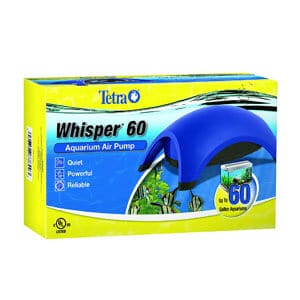
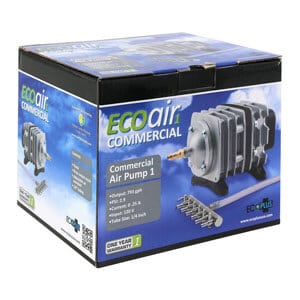
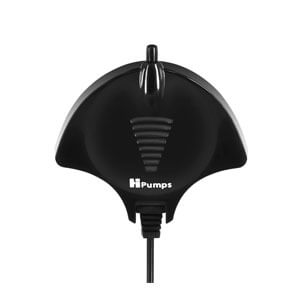
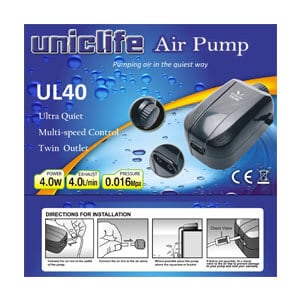
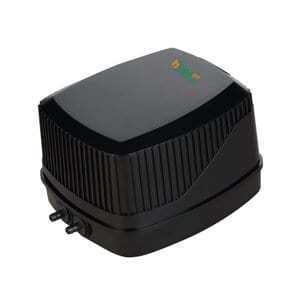
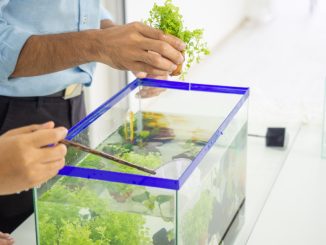
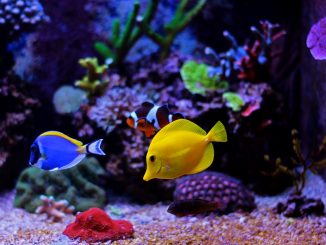
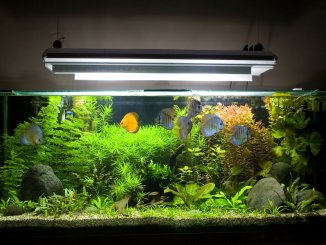
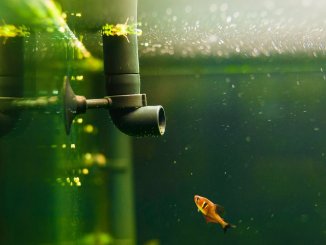

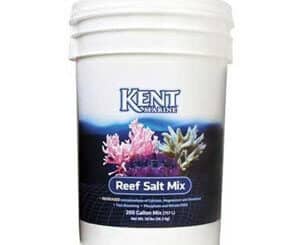
I had a good supply of medical oxygen tubing, both clear and green, which happens to be the correct size for aquarium airline fittings. I had one small air pump that was running a small bubble-up filter and an airstone with low-to-moderate flow in each. I then used a length of the beautiful green O2 tubing to connect yet another airstone, but the airstone didn’t work.
Because I had been using one airstone from a pack of imported airstones and it only bled air from a small area, I figured the second airstone was even worse, and didn’t work at all. I went back into the tank and swapped airstones with another from the pack…no joy. I then blew through the tubing and could see air coming from the wet airstone. Obviously, my pump was insufficient, and I was thinking how lame it was to not be able to run a couple airstones at low rate along with a small bubble-up filter (also run low for baby fish and shrimp).
I bought a new pump, the Tetra 40 gallon Whisper. I hooked it up to the three devices and the original two still worked, but not the last airstone. I then thought I had underestimated the pump capacity needed to drive the load I had, so I split the load and put pump #1 back on line, and even with only the last airstone, I still could not get airflow through the last airstone.
I am embarrassed to say how much fooling around it took me to finally figure out that the hose was the problem. I even flipped the hose end-for-end in case there was an internal check valve I wasn’t seeing.
The problem ended up being with the medical oxygen tubing anyway though. It is kink-resistant…and this is achieved by having three small, equally spaced ridges inside the hose to reinforce the walls. All of the O2 hoses had slip-on fittings attached to the end of the hose, which I had cut off. When the hose itself is slipped over a standard fitting, enough air leaks back out through the gaps between the internal ridges that the either pump could only push the water down the hose about 2″ and couldn’t get enough pressure to drive the air all the way to the bottom of the tank. I got quite the workout and education. When I simply used a length of regular aquarium airline, everything worked fine, so of course I felt like an idiot.
The Tetra air pump, by the way, works well, but is a little louder than I had hoped. I will admit I am within a few feet of it and it’s on a hard floor. If I could have placed it on a carpeted surface further away, it might be fine.
I have been using the Hygger “Best Aquarium Pump” for the last 3 months. I love it. I am powering a 60” air curtain at a 30” depth. This pump has no problem overpowering this curtain. No other pump has been able to do this. I am very impressed.
With this pump if you do not run a fish store you will have the task of throttling it down. I am having a very difficult time finding valves that have the fine control that is needed. In my childhood 50 years ago we had nice needle valves for this task. Searching Amazon for hours I cannot find anything that has fine control. Massive numbers of gang valves all with coarse lever controls. Can anyone address how they manage the fine tuning that this wonderful pump requires?